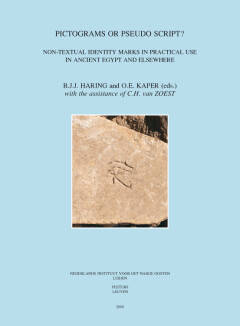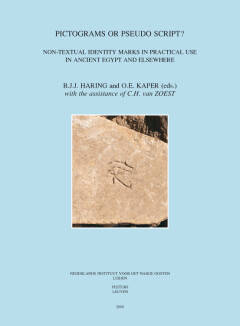
- Afhalen na 1 uur in een winkel met voorraad
- Gratis thuislevering in België vanaf € 30
- Ruim aanbod met 7 miljoen producten
- Afhalen na 1 uur in een winkel met voorraad
- Gratis thuislevering in België vanaf € 30
- Ruim aanbod met 7 miljoen producten
Pictograms or Pseudo Script?
Non-Textual Identity Marks in Practical Use in Ancient Egypt and Elsewhere. Proceedings of a Conference in Leiden, 19-20 December 2006
Haring B J J Kaper O E
€ 96,95
+ 193 punten
Omschrijving
Marking systems such as masons' marks, property marks, pot marks, quarry marks and team marks confront us with the large variation in the use of graphic signs. They are often similar to writing, yet they are not script in the strictest sense of the word. The practical purposes of marks include claims to property and responsibilities, both individual and collective, for which also regular scripts are used. The marking systems are seen to operate in combination with writing, but frequently also in isolation. In societies that use writing, the marks appear to be strongly influenced by it: their shapes are often identical and they may be similarly arranged in lines or columns. In this sense the marking systems may be called a pseudo script, for in spite of their resemblance to writing, the signs remain mere pictograms. This volume brings together for the first time the results of research on practical marking systems in ancient Egypt and other cultures, making it possible to define the common characteristics of their appearance and their uses. It is the result of a conference hosted by the Egyptology Department at Leiden University in 2006. The great geographical and chronological range covered by the volume, the sign corpora added to many of the contributions, and the indices also make it the first important reference work on this intriguing topic.
Specificaties
Betrokkenen
- Auteur(s):
- Uitgeverij:
Inhoud
- Aantal bladzijden:
- 236
- Taal:
- Engels
- Reeks:
- Reeksnummer:
- nr. 25
Eigenschappen
- Productcode (EAN):
- 9789042923140
- Verschijningsdatum:
- 31/12/2009
- Uitvoering:
- Paperback
- Formaat:
- Trade paperback (VS)
- Afmetingen:
- 193 mm x 264 mm
- Gewicht:
- 748 g

Alleen bij Standaard Boekhandel
+ 193 punten op je klantenkaart van Standaard Boekhandel
Beoordelingen
We publiceren alleen reviews die voldoen aan de voorwaarden voor reviews. Bekijk onze voorwaarden voor reviews.










